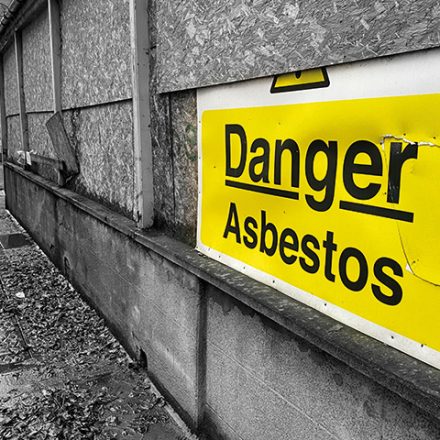Steps to take if exposed to Asbestos
Asbestos is the name for minerals that are made of fibres found naturally in the earth. These minerals have been used in construction and manufacturing for a number of years for many reasons: Asbestos fibres are flexible and resistant to heat, fire and electricity. This is why they have been used in home and business construction materials and even textiles.
Use of asbestos is now banned in the UK, but buildings constructed prior to 2000 may still have asbestos present in them.
Asbestos exposure happens when microscopic asbestos fibres become airborne. Many people are exposed through their occupations. The toxic mineral dust can remain in the air for hours, placing anyone nearby in danger of inhaling or ingesting it.

What diseases are caused by Asbestos?
This is one of the most common asbestos related diseases. It is caused by inhaling asbestos fibres. Generally, symptoms may not appear until many years after exposure.
This is a type of cancer that begins to grow in the lining of certain organs, most commonly the lungs. However, it can also affect the abdomen or the heart. The main cause of mesothelioma is breathing in asbestos dust, with the most common type of mesothelioma being epithelioid.
The most common kind of lung cancer is non-small cell lung cancer (NSCLC). Unfortunately, anyone can develop lung cancer, but it is most common in people who smoke or used to smoke.
The above are the most common conditions that develop because of asbestos exposure. However, there are various conditions that may develop that are not cancerous or life-threatening:
On their own, pleural effusions are not immediately life-threatening. Over time, they may cause pain and interfere with breathing.
Pleural plaques is a condition that occurs frequently after asbestos exposure. These calcified build-ups are not considered a serious health issue, but they can make breathing painful if they become very thick.
Symptoms of Asbestos Exposure
You may not experience any symptoms until many years after you are exposed. The most common symptoms appear to be:
- pain or tightness in the chest;
- a repetitive cough that worsens;
- struggling for breath;
- difficulty swallowing;
- weight loss.
Steps to take if you have been exposed to Asbestos
It’s vital that your GP is made aware and therefore you should visit them immediately. It’s not always a reason to worry as most people do not develop serious or life-threatening lung disease as a result of exposure to asbestos. However, please seek medical advice if you have any of the above symptoms., or if your employment history had any potential asbestos risk in the past.
If you think you have found asbestos at your home, then it is in your interests to contact an environmental health officer at your local council as they will be able to provide assistance as to how the asbestos can be removed and what steps you should take to protect yourself and your family.

Financial Assistance and Compensation
If you are diagnosed with an asbestos related condition, you can apply for industrial injuries benefits from the Department for Work and Pensions. In order to recover such benefits, you must be suffering from what is known as a prescribed disease. The DWP will be able to assist in this regard.
There are also government compensation schemes that are available pursuant to the Pneumoconiosis etc (Workers’ Compensation) Act 1979.
An award of Industrial Injuries Disablement Benefit may lead to entitlement to a payment under the above scheme provided your disease was caused by your employment, you have not brought a court action or received compensation from your employer in respect of the disease, and you have not taken action because your former employer has ceased trading.
Applications to this scheme must be made within 12 months of being awarded Industrial Injuries Disablement Benefit. Applications beyond this period will only be considered in exceptional circumstances. Any award that you receive under this scheme is determined by age and a percentage of disablement award received.
Please note that a payment under the above Act/scheme may adversely affect any existing entitlement you have to other government means-tested benefits including Universal Credit or Housing Benefit.

Diffuse Mesothelioma payments
You may be entitled to a payment if you have been diagnosed with diffuse mesothelioma. There are two types of payment you can claim:
- diffuse mesothelioma payments (the ‘2008 scheme’)
- the Diffuse Mesothelioma Payment Scheme (DMPS)
You can claim DMPS if you cannot find the employer responsible for your contact with asbestos, or their insurer. The payment that you may receive under the above schemes depends on various factors including your age when diagnosed with the condition. You will only receive a one-off payment under the 2008 scheme if you are not entitled to a payment under the 1979 Pneumoconiosis Act.
Bringing a Claim Against a Previous Employer
You may wish to make a claim against a previous employer who exposed you to asbestos.
Support and Advice Groups
Asbestos Victims Support Groups Forum is a useful place to look for benefits advice and support.
If you believe you have been exposed to asbestos and/or have been diagnosed with an asbestos related condition, please do not hesitate to contact our Bradley Wright on Bradley.Wright@edslaw.co.uk 0208 514 9000 for advice on a No Win, No Fee basis.
